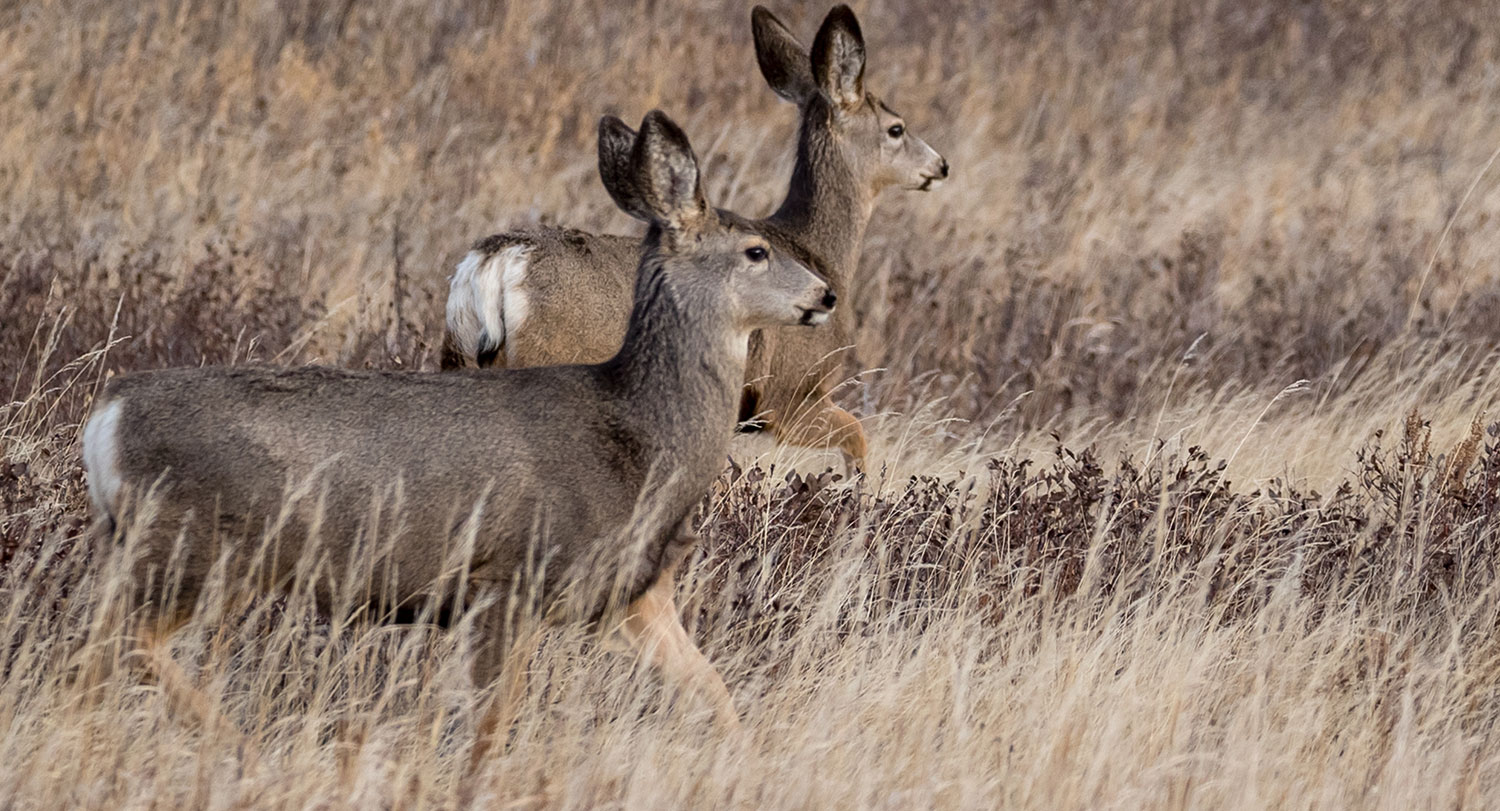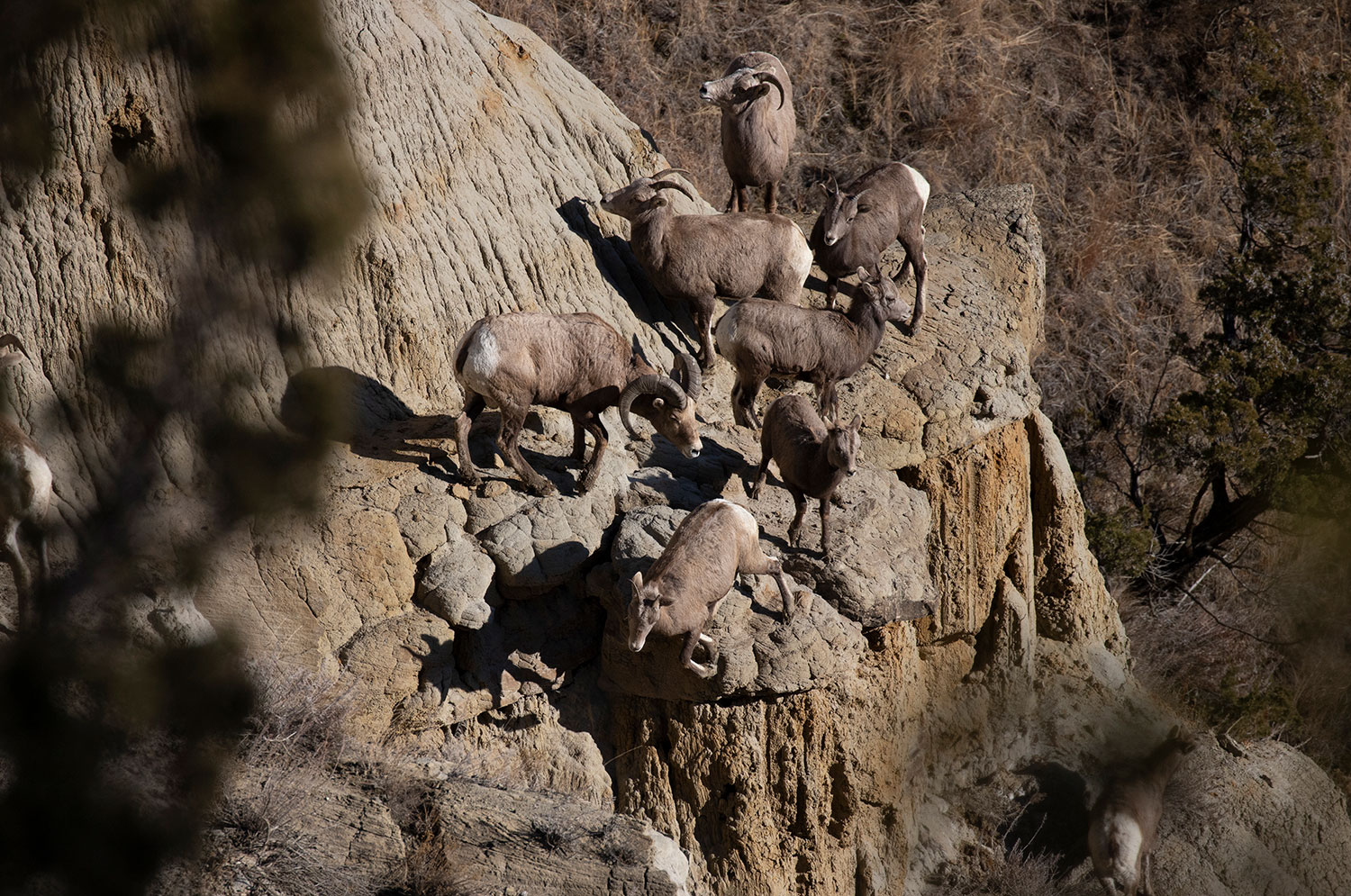
Buffaloberry Patch
Spring Mule Deer Survey Complete
Drought Likely to Impact Duck Production
Very dry conditions, along with a decline in numbers of breeding ducks compared to last year, were found during the North Dakota Game and Fish Department’s 74th annual breeding duck survey.
The 2021 May water index was down 80% from 2020, and nearly 68% below the 1948-2020 average. The percentage-based change in the number of wetlands holding water is the greatest seen in the history of the survey.
Mike Szymanski, Department migratory game bird management supervisor, said 2020 was the sixth wettest year and 2021, according to the survey, is the fifth driest in 74 years.
“That’s an indication of how dynamic this system is that we work in,” he said. “We essentially have no temporary and seasonal basins holding water on the landscape right now. And that has huge ramifications for duck production in the state.”
A drastic decline in areas for ducks to establish pair territories and for hens to find high quality forage for egg production doesn’t bode well for whether ducks will decide to nest.
“If a hen sees an area with poor or declining wetland conditions, she’s going to work under the assumption that there’s no place to raise a brood later,” Szymanski said. “Even though we counted a fairly large number of ducks (2.9 million) on our survey, most of those ducks are not going to nest unless we have a very, very dramatic change on the landscape.”
While this year’s breeding duck index was down nearly 27%, it was above the 73-year average by about 19%, and the 48th highest on record.
Indices decreased for all primary species from 2020, including mallards (-48.7%), representing the 28th highest count on record, but the lowest since 1993. Some of North Dakota’s other common species dropped below their long-term averages, most notably pintails (-68%), with their lowest count since 1991.
The exception was a 47% increase in the gadwall index from 2020.
“We have seen these oddities in the gadwall index when coming abruptly from wet conditions to rather dry conditions,” Szymanski said. “Being a late-nesting species, gadwall that won’t breed this year are still in the process of aggregating for departure to more secure molting habitats.”
Szymanski said typically it’s probably too early to make any big predictions about the coming fall hunting season. Yet, based on how things are playing out in North Dakota and much of the Prairie Pothole Region, it’s likely going to be tough hunting without a lot of young birds in the air.
“Of course, we’ll do a duck brood survey in July to get another handle on habitat conditions and what we see for production,” Szymanski said. “But based on social mannerisms of ducks right now, it seems like there is very little breeding activity happening.”
Record Count on Bighorn Sheep
Wildlife Crossings
Plan Before Hitting the Water
With some access sites unusable because of low water levels, boat ramps are likely to be more congested than usual this year. With that in mind, boaters are reminded to plan accordingly when heading to a lake or river this summer.
The North Dakota Game and Fish Department receives complaints every year about overly aggressive behavior at boat ramps. A few simple reminders will help ensure a fluent transition when launching and loading a boat.
Launching
- Don't pull onto the ramp until your boat is ready to launch.
- Prepare for launching in the parking area. Remove covers, load equipment, remove tie downs, attach lines and put in drain plug before backing onto the ramp.
- When ready, pull into line to launch. Wait your turn. Be courteous.
- '
Loading
- Don't block the loading area with your boat until your tow vehicle is ready to load. Wait until you are clear of the launch area to unload gear.
- As soon as your trailer is in the water, load and secure your boat to the trailer.
- Remove boat and trailer from the water as quickly as possible.
- Get clear of the ramp. Pull into the parking area to finish securing your boat, unloading gear, draining all water and inspecting for and removing any vegetation. Remember to leave plugs out when transporting your boat.
White Suckers Only Legal in Bois de Sioux, Red Rivers
The state Game and Fish Department reminds anglers that live white suckers are not legal baitfish anywhere in North Dakota, except in the Bois de Sioux and Red rivers.
Although anglers can use live white suckers on the Bois de Sioux and Red rivers, and tributaries up to the first vehicular bridge, they are illegal elsewhere.
Fathead minnows, sticklebacks and creek chubs are the only legal live baitfish outside of the Bois de Sioux and Red rivers. Dead white suckers, which have been preserved by freezing, salting or otherwise treated to inactivate reproductive capabilities are legal bait.
Transportation of live white suckers, other than in Richland, Cass, Traill, Grand Forks, Walsh and Pembina counties, is illegal.
Illegal to Import Live Aquatic Bait
Anglers are reminded that it is illegal to import minnows and other forms of live aquatic bait into North Dakota.
Anglers must buy bait from a licensed North Dakota retail bait vendor. Bait vendors can properly identify species and ensure all bait is clean of any aquatic nuisance species.
For more information, refer to the 2020-22 North Dakota Fishing Guide, available at license vendors or online at the state Game and Fish Department website, gf.nd.gov.
Leave Baby Animals, Watch for Deer
The North Dakota Game and Fish Department offers a simple message to people who want to pick up and rescue what appear to be orphaned baby animals this time of year – don’t touch them. Whether it is a young fawn, duckling, cottontail rabbit or a songbird, it is better to just leave them alone.
Often, young animals are not abandoned or deserted, and the mother is probably nearby. Young wildlife are purposely placed in seclusion by adults to protect them from predators.
Anytime a young wild animal has human contact its chance for survival decreases significantly. It’s illegal to take wild animals home, and captive animals later returned to the wild will struggle to survive because they do not possess learned survival skills.
The only time a baby animal should be picked up is if it is in an unnatural situation, such as a young songbird found on a doorstep. In that case, the young bird could be moved to the closest suitable habitat.
People should also steer clear of adult wildlife, such as deer or moose that might wander into urban areas. Crowding stresses animals, and this could lead to a potentially dangerous situation.
In addition, motorists are reminded to watch for deer along roadways. During the next several weeks young animals are dispersing from their home ranges, and with deer more active during this time, the potential for car deer collisions increases.
Put Garbage Where it Belongs
The North Dakota Game and Fish Department reminds outdoor recreationists to keep it clean this summer by packing out all trash.
All garbage, including used fireworks, should be placed in a proper trash receptacle. If trash cans aren’t available, or are full, take the trash and dispose of it at home.
It is not uncommon to see garbage piling up around full trash containers. Styrofoam containers are not biodegradable, but are often found wedged in cattails, drifting, or washed up on shore.
Tires, mattresses and kitchen appliances have found their way to public use areas. This illegal dumping is costly to clean up and takes a significant toll on the environment. Not only does it spoil the beauty of the land, it destroys habitat, has the potential to pollute North Dakota waters and can injure wildlife.
Littering violations should be reported by calling the Report All Poachers hotline at 701-328-9921.
State Archers Shine at NASP Nationals
Much like 2021 National Archery in the Schools Program State Tournament, the NASP National Tournament was also held virtually this year. North Dakota had a record number of archers participating in nationals at 257, more than double the number representing the state.
North Dakota was represented well with 11 top 10 placements.
Bulls-eye
Shayle Zimbleman, Oakes, 2nd place, middle school girls; Hunter Genre, New Rockford, 8th place, middle school boys; Isiah Wertz, Oakes, 10th place, middle school boys; Gracie Gunderson, Medina, 2nd place, high school girls; Mason Kamlitz, Oakes, 3rd place high school boys; and Casey Everson, Barnes County North, 9th place, high school boys.
3-D
Shayle Zimbleman, Oakes, 5th place, middle school girls; Hunter Genre, New Rockford, 2nd place, middle school boys; Braysen Sagert, Oakes, 9th place, middle school boys; Gracie Gunderson, Medina, 10th place, high school girls; Clancey Zimbleman, Oakes, 4th (tied) place, high school boys; and Mason Kamlitz, Oakes, 4th (tied) place, high school boys.
Varsity Archery Tournament Top Finishers
Octavia Ralph-Martinson, a junior at Griggs County Central, took top honors in two disciplines in the 2021 Varsity Archery State Tournament.
Varsity Archery is a spin-off of the National Archery in the Schools Program and is open to only high school-aged kids. While formatted similarly to the popular NASP, Varsity Archery allows its participants to use fully equipped bows and the distances to the targets can be greater. There is also greater variation in the type of targets the kids might encounter in their classroom or at a tournament. This gives archers coming out of NASP a taste of what archery has to offer outside of the gymnasium.
Octavia took the overall championship by taking top honors in both disciplines, shooting a 296 in the bulls-eye, or Olympic style competition, and a perfect 300 in the 3-D competition.
Here’s the top 3 boys and girls for the Varsity Archery State Tournament:
3-D
- Boys
- First – Joshua Wiebusch, Wahpeton
- Second – Jordan Carlson, Barnes County North
- Third – Clancey Zimbleman, Oakes
- Girls
- First – Octavia Ralph-Martinson, Griggs County Central
- Second – Rylee Suhr, Griggs County Central
- Third – Melonie Lee, Barnes County North
Bulls-eye
- Boys
- First – Alex Lee, Barnes County North
- Second – Clancey Zimbleman, Oakes
- Third – Jordan Carlson, Barnes County North
- Girls
- First – Octavia Ralph-Martinson, Griggs County Central
- Second – Rylee Suhr, Griggs County Central
- Third – Brooke Bundy, Barnes County North




